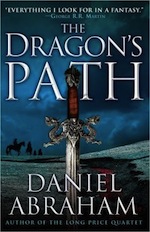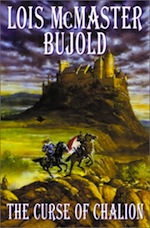Now, before we get started, allow me to be clear: grimdark is great! It has its place in the fantasy spectrum, and many works that fall under the grimdark or gritty heading are classics. Obviously, we here at Tor.com love our Abercrombie and Martin—which, really, they need to also be a vaudeville team—but sometimes we want a fantasy that’s more optimistic. Just a little, guys! C’mon, we’re not asking for much…
The Goblin Emperor—Katherine Addison

Katherine Addison’s delightful novel is about many things, but at its (lovable) heart it’s a story about realizing that sometimes your quirks are your greatest strengths. Maia, half-elven, half-goblin, becomes Emperor when his father and three elder brothers are assassinated. He has to learn how to rule a distrustful kingdom while he investigates the murder, navigates the byzantine politics of his (primarily Elven) court, and, hardest of all, stays true to himself. The story doesn’t shy away from the horrors of executions or the ugliness of prejudice, but it also focuses on the power of compassion to bridge social differences and effect change.
The Face in the Frost—John Bellairs

A wizard named Prospero (not that one) teams up with his old friend, the adventurer Roger Bacon (OK, maybe that one), to confront an evil power attacking their kingdom. They know going into the fight that they’re outmatched, but what else can they do? Bellairs’ story, like all of his work, juggles truly effective horror with quirky humor. The book gives weight to both elements, owning up to the terror that would come with a fight against evil, but also never wallowing in that terror to the point of overwhelming the humanity of the book.
The Copper Promise—Jen Williams

Williams’ novel combines some of the tropes of grimdark, e.g. mercenaries, torture, and tragic backstories, with some of the higher ideals of sword and sorcery. Best of all, it treats what could have been a slog through brutal battles as a lighthearted adventure. This bright tone, combined with a biting sense of humor, make the book fun as well as epic. The fallen knight is more complicated than we think, the swordswoman-for-hire is as handy with snark as she is with a sword, and… what’s this? The main character’s arc is one of rediscovering his humanity after a horrible trauma, rather than a slow degradation into despair? Is it possible?
Riftwar Series—Raymond E. Feist

Several denizens of Twitter suggested Feist’s work as an antidote to grit! The central conceit of the Riftwar books are the rifts themselves—they can join worlds, but those who travel through them can seek communication and exploration, or war and conquest, and the series explores many permutations of these choices. Sure, it has has war right there in the name, but it also has characters who are willing to sacrifice themselves for the greater good, who take chances on trusting each other (and have that trust rewarded), rulers who choose mercy over murder, and candidates for the throne who abdicate so that better people can lead. We’re a long way from Westeros when we’re reading Feist.
Shannara Series—Terry Brooks

These are more high fantasy style, involving hero quests in addition to mundane acts of heroism. As he says in his 2003 book Sometimes the Magic Works, his “protagonists are cut from the same bolt of cloth as Bilbo and Frodo Baggins. It was Tolkien’s genius to reinvent the traditional epic fantasy by making the central character neither God nor hero, but a simple man in search of a way to do the right thing….I was impressed enough by how it had changed the face of epic fantasy that I never gave a second thought to not using it as the cornerstone of my own writing.“
Chrestomanci Series—Diana Wynne Jones.

All of Diana Wynne Jones’ books could be on this list, but we’ll stick with the Chrestomanci Series, and particularly, The Lives of Christopher Chant. People die, parents split up, and villainous uncles trick nephews into nefarious schemes, but Wynne Jones still gives us characters to root for and dashes of hope. Christopher Chant himself is good-hearted (occasionally bitchy, but good-hearted), going out of his way to help a young goddess, and forging a friendship with the awesomely-named Throgmorten the Cat.
The Sun, the Moon, and the Stars—Steven Brust
Brust’s novel is about a painter creating oil paintings and putting an art show together. It’s also a retelling of the Hungarian tale of Taltos, who uses expert-level trickster skills to con the sun, moon, and stars away from the monsters who own them. The stories parallel each other in fascinating ways, but much of the weight is given to the modern story of a person who is part of both an artistic community and a supportive relationship. This allows the book to work as an inspiring tale of the value of art, rather than just another quirky fairytale mashup.
Range of Ghosts—Elizabeth Bear
 Range of Ghosts, the first book in Bear’s Eternal Sky trilogy, gives us an epic fantasy world influenced by Central Asian culture. Temur, a grandson of the Great Khagan, and Samarkar, the former princess of the Rasa dynasty who abdicated her royalty to become a wizard, must stand together against the hidden cult that has caused civil war throughout the empires of the Celadon Highway. While this is a complex book, with layers of religious tradition and political intrigue, Bear also focuses on the characters at the story’s center, and, as Liz Bourke said in her review, “the significance of a single life, united with other single lives,” and “moments of kindness and stillness amidst the horror of war,” creating an epic with a beating, human heart.
Range of Ghosts, the first book in Bear’s Eternal Sky trilogy, gives us an epic fantasy world influenced by Central Asian culture. Temur, a grandson of the Great Khagan, and Samarkar, the former princess of the Rasa dynasty who abdicated her royalty to become a wizard, must stand together against the hidden cult that has caused civil war throughout the empires of the Celadon Highway. While this is a complex book, with layers of religious tradition and political intrigue, Bear also focuses on the characters at the story’s center, and, as Liz Bourke said in her review, “the significance of a single life, united with other single lives,” and “moments of kindness and stillness amidst the horror of war,” creating an epic with a beating, human heart.
The Dragon’s Path—Daniel Abraham

The Dragon’s Path is epic fantasy that picks up after the dragons have gone, leaving behind thirteen races who were bred to serve them. Now those races squabble and war with each other as they try to map an economy and political destiny. While there is a lot of page-time spent on pseudo-Renaissance banking systems, Abraham also takes the time to give us several point-of-view characters that enrich the story with humanity. He chooses to focus on a higher-class couple who would probably be the villains in most books, but here are made worthy of empathy.
Little Big—John Crowley

Little, Big unfolds over nearly a century, as the Drinkwater clan builds an intricate relationship with the world of faerie. We meet the human family, hear rumors of magical beings, visit a dystopian City, and spend some time with a Grandfather Trout who might be a cursed prince. Crowley isn’t afraid to slow down and ponder heady subjects like free will and fate, or to tell his story through intricate detail and gorgeous language, which led to a novel that Ursula le Guin said, “…all by itself calls for a redefinition of fantasy,” and Thomas Disch called “the best fantasy novel ever. Period.”
Lyonesse Trilogy—Jack Vance

This trilogy melds Arthurian stories, chivalric tropes, and Celtic mythology into a story of a despotic king, his daughter, and her lover. Since Vance took elements from several different medieval periods and used those elements to bring life to his own magical lands, he can play around with references to stories and echoes of themes, such as the fall of Atlantis, without being tied to an expected narrative. While the story itself is not exactly lighthearted, it does feature plenty of humor, fun, and romance. He also uses the Atlantean references to tinge the whole story with melancholy—how long can Lyonesse last? Does the possibility of the Kingdom’s end overshadow the joy that can be had in the moment?
The Innkeeper’s Song—Peter S. Beagle.

We talk about The Last Unicorn a lot on this site, because The Last Unicorn is fucking awesome. But! Peter S. Beagle did so much more! So when a Twitterer mentioned Beagle’s work, I decided to highlight The Innkeeper’s Song. Beagle jumps across multiple points of view to weave several different quests together. Tikat pursues his childhood love, whom he saw resurrected by magicians. Lal and Nyateneri, the magicians, are racing to save their old mentor from his powerful but evil student. Lukassa, the resurrected girl, has her own path to pursue. And the Innkeeper himself must take them all in, even though he knows they bring trouble with them. Through nested quests and elegant language, Beagle tries to get to the heart of death, love, and duty.
The Curse of Chalion Series—Lois McMaster Bujold

This series is a melding of fantasy and theology informed by elements of medieval Spanish history and mysticism, especially the reign of Ferdinand and Isabella in the late 15th Century. The Curse of Chalion follows Lupe dy Cazaril, who returns home after war and enslavement to try to live a quiet life, but instead finds himself working to lift the curse that lays on the royal family that has acted as his patron. A little bit epic, a little bit slice of (imaginary, alternate universe) life, the series takes questions of morality and duty seriously, without succumbing to endless bouts of violence or despair.
So, this is our list, but we’re sure there are more upbeat fantasies out there—give us your suggestions! Do you want some light to cut through the grimdarkness, or are do you prefer your fantasy as gritty as possible?
Leah Schnelbach believes that the grimdarkness of her own personal far future will be averted if she gets to read a sequel to The Goblin Emperor.










